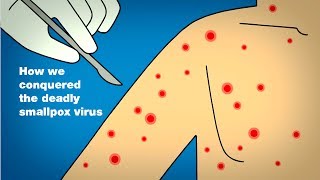(单词翻译:单击)
10,000 years ago, a deadly virus arose in northeastern Africa.
一万年前,在非洲东北部出现了一种致命的病毒。
The virus spread through the air, attacking the skin cells, bone marrow, spleen, and lymph nodes of its victims.
这种病毒通过空气传播感染皮肤细胞、骨髓、脾脏以及淋巴系统。
The unlucky infected developed fevers, vomiting, and rashes.
不幸的感染者会高烧、呕吐和皮疹。
30% of infected people died during the second week of infection.
百分之三十的感染者会在感染两周内死亡。
Survivors bore scars and scabs for the rest of their lives. Smallpox had arrived.
幸存下来的人也会留下永久性的伤疤与结痂,这个病毒就是天花。
In 1350 B.C., the first smallpox epidemics hit during the Egypt-Hittite war.
天花第一次爆发是在公元前1350年埃及与西台的战争期间。
Egyptian prisoners spread smallpox to the Hittites, which killed their king and devastated his civilization.
埃及的囚犯把天花传染给西台人,甚至导致西台国王的死亡,并摧毁了西台文明。
Insidiously, smallpox made its way around the world via Egyptian merchants,
不知不觉地,天花遍布全世界,由埃及商人
then through the Arab world with the Crusades, and all the way to the Americas with the Spanish and Portuguese conquests.
经由征战传播到阿拉伯世界,后来因西班牙与葡萄牙的入侵而传到美洲。
Since then, it has killed billions of people with an estimated 300 to 500 million people killed in the 20th century alone.
从那时开始,天花导致数十亿人的死亡,光是在二十世纪就造成约三至五亿人口死亡。
But smallpox is not unbeatable. In fact, the fall of smallpox started long before modern medicine.
但天花并非无药可解。事实上,天花早在现代医学开始前就已经逐渐减少。
It began all the way back in 1022 A.D.
这要从公元1022年开始说起。
According to a small book, called 'The Correct Treatment of Small Pox,'
一本名为《治疗天花正确疗法》的书,
a Buddhist nun living in a famous mountain named O Mei Shan in the southern providence of Sichuan
记载着一名住在四川南部峨眉山上的尼姑,
would grind up smallpox scabs and blow the powder into nostrils of healthy people.
将天花所造成的疙瘩磨碎,并将疙瘩粉吹入健康者的鼻孔里。
She did this after noticing that those who managed to survive smallpox never got it again, and her odd treatment worked.
她这么做是因为注意到那些从天花中幸存下来的人从此不再感染,而她这种特殊的疗法起到了效果。
The procedure, called variolation, slowly evolved and by the 1700's,
这个被称为天花接种的疗法慢慢演化,到了十八世纪,
doctors were taking material from sores and putting them into healthy people through four or five scratches on the arm.
医生从病人的疮疤中撷取部分,在健康者的手臂刮四到五次后,并将撷取物置入其中。
This worked pretty well as inoculated people would not get reinfected, but it wasn't foolproof.
这个方法相当有效,接种过的人们从此不再被感染。但这方法并非全然无虞。
Up to three percent of people would still die after being exposed to the puss.
仍有3%的人会在接种后会死亡。
It wasn't until English physician Edward Jenner noticed something interesting about dairy maids that we got our modern solution.
直到有位叫爱德华·琴纳的英国医师察觉到发生在牧场少女身上的有趣现象,现代医学的解法才出现。
At age 13, while Jenner was apprentice to a country surgeon and apothecary in Sodbury, near Bristol,
在琴纳十三岁时,他还是布里斯托附近的萨德贝礼的一名外科医师兼药剂诗的学徒,
he heard a dairy maid say, 'I shall never have smallpox, for I have had cowpox. I shall never have an ugly, pockmarked face.'
他听到一名牧场少女说,“因为我得过牛痘,所以不会得天花。我不会有那满脸痘痕的丑脸。”

Cowpox is a skin disease that resembles smallpox and infects cows.
牛痘是一种和天花很像,但感染在牛身上的皮肤病。
Later on, as a physician, he realized that she was right,
不久后,身为医生的他发现这个女孩所说是正确的,
women who got cowpox didn't develop the deadly smallpox.
感染过牛痘的女性都没有得致命的天花。
Smallpox and cowpox viruses are from the same family.
天花与牛痘是同源的。
But when a virus infects an unfamiliar host, in this case cowpox infecting a human, it is less virulent,
但感染的宿主不同,牛痘感染在人身上毒性较弱,
so Jenner decided to test whether the cowpox virus could be used to protect against smallpox.
因此琴纳决定来做个实验,看看牛痘是否能用来对抗天花病毒。
In May 1796, Jenner found a young dairy maid, Sarah Nelmes,
1796年5月,琴纳发现一名叫莎拉·芮姆的农家女孩
who had fresh cowpox lesions on her hand and arm caught from the utters of a cow named Blossom.
从一头叫布洛森的牛身上感染到牛痘病毒。
Using matter from her pustules, he inoculated James Phipps, the eight-year-old son of his gardener.
他用莎拉脓包里的萃取物将之接种到他园丁的八岁儿子詹姆士·菲普身上
After a few days of fever and discomfort, the boy seemed to recover.
经过几天的发烧与不适,这个小男孩渐渐康复了。
Two months later, Jenner inoculated the boy again, this time with matter from a fresh smallpox lesion.
两个月后,琴纳接种天花病毒的脓包萃取物到这小男孩身上。
No disease developed, and Jenner concluded that protection was complete. His plan had worked.
没有引发疾病,琴纳因此断定这个方式是有效的。他的计划成功了。
Jenner later used the cowpox virus in several other people and challenged them repeatedly with smallpox,
琴纳接着用牛痘病毒接种到其他人身上,并以天花病毒不断试验,
proving that they were immune to the disease.
证明接种牛痘后这些人将对天花病毒免疫。
With this procedure, Jenner invented the smallpox vaccination.
琴纳发明了牛痘疫苗接种。
Unlike variolation, which used actual smallpox virus to try to protect people,
不像天花疫苗接种是使用天花的病毒来保护人们,
vaccination used the far less dangerous cowpox virus.
牛痘接种是用毒性较弱的牛痘病毒。
The medical establishment, cautious then as now, deliberated at length over his findings before accepting them.
这项医学创举的严谨度不输现代科学,经过很长时间,才有人渐渐接受它。
But eventually vaccination was gradually accepted and variolation became prohibited in England in 1840.
但到最后还是被众人肯定,而英国也在1840年禁止天花接种。
After large vaccination campaigns throughout the 19th and 20th centuries,
在19到20世纪长时间的努力之后,
the World Health Organization certified smallpox's eradication in 1979.
世界卫生组织确认天花在1979年被根除。
Jenner is forever remembered as the father of immunology,
琴纳也因此被称为免疫学之父,永留青史,
but let's not forget the dairy maid Sarah Nelmes, Blossom the cow, and James Phipps,
但我们也别忘了农家女孩莎拉·芮姆,那头叫布洛森的牛,还有詹姆士·菲普
all heroes in this great adventure of vaccination who helped eradicate smallpox.
而这些无名英雄都是根除天花病毒的大功臣。


